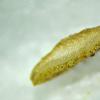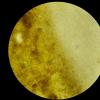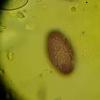
24-12-2025 17:08
Hulda Caroline HolteHello, I have found this propoloid ascomycete on

21-12-2025 09:32
Hello.A tiny ascomycete found embedded in wood in

21-12-2025 21:32
Pol DebaenstHello, Garden, Burgweg 19, Veurne, BelgiumOn 10/1

22-12-2025 23:38
Patrice TANCHAUDBonsoir, récolte sur un mur en pierre, apothéci

22-12-2025 00:47
Patrice TANCHAUDBonsoir, récolte à proximité du milieu dunaire
Am I right or totally wrong with Ascobolus geophilus?
Maria Plekkenpol,
14-09-2019 21:53
 Holland, 07-09-2019. In riverclay area on soil (old piece of riverbank). Apothecium yellowish/greenish, darkening into brown when older, largest 2,5-3 mm. Asci clavate, 155-190 x 18-20, no Meltzer reaction (J-).
Holland, 07-09-2019. In riverclay area on soil (old piece of riverbank). Apothecium yellowish/greenish, darkening into brown when older, largest 2,5-3 mm. Asci clavate, 155-190 x 18-20, no Meltzer reaction (J-).Spores mature deep purple, young hyaline. I think I saw very fine granulation in the young spores, as well as fine warts. Mature spores with fissures/reticulated, 19-21 x 10-13.
Paraphyses slender, longer than the asci, yellow(ish). Septated, sometimes forked, with a slightly swollen top (not all of them).
Following van Brummelen I came to Ascobolus geophilus, but maybe I'm very wrong :)
What is your opinion? Thanks in advance!
Michel Delpont,
15-09-2019 09:08

Re : Am I right or totally wrong with Ascobolus geophilus?
Hello Maria.
Interesting! It is sometimes difficult to separate certain species of this genus. Compares with A.behnitziensis near geophilus. According to Dissing, geophilus spores are later adorned ornamented, unlike behnitziensis. Also try to make other preparations in the Melzer showing the asci; you say negative Melzer whereas normally the reaction must be positive.
Michel.
Viktorie Halasu,
15-09-2019 09:29

Re : Am I right or totally wrong with Ascobolus geophilus?
Hello Maria,
van Brummelen states that only very young asci are amyloid in A. behnitziensis - i.e., the blueing might be visible only in lower part of the hymenium, see here: https://www.nahuby.sk/obrazok_detail.php?obrazok_id=606132
Cheers,
Viktorie
van Brummelen states that only very young asci are amyloid in A. behnitziensis - i.e., the blueing might be visible only in lower part of the hymenium, see here: https://www.nahuby.sk/obrazok_detail.php?obrazok_id=606132
Cheers,
Viktorie
Maria Plekkenpol,
15-09-2019 10:09

Re : Am I right or totally wrong with Ascobolus geophilus?
Thank you both very much for your quick reply! Sadly I only found two little fruitbodies and the material I tried to save has turned bad. What I can say is that the material I examined did have mature but also very young asci and I looked at your link Victorie, but there was no blue colouring anywhere in the hymenium.
Michel, what I read in van Brummelen about geophilus:
Asci cylindric-clavate, tapering
downwards, rounded above, 160-200 X 17- 20 p. (according to Seaver rgr6, I.e.:
"200-250 X 15- 18 p,"), 8-spored; the wall not, or scarcely, blue in Melzer's reagent.
So I am now a bit confused?
Michel, what I read in van Brummelen about geophilus:
Asci cylindric-clavate, tapering
downwards, rounded above, 160-200 X 17- 20 p. (according to Seaver rgr6, I.e.:
"200-250 X 15- 18 p,"), 8-spored; the wall not, or scarcely, blue in Melzer's reagent.
So I am now a bit confused?
Michel Delpont,
15-09-2019 12:07

Re : Am I right or totally wrong with Ascobolus geophilus?
As stated by Viktorie the reaction is sometimes weak and only on young asci, especially on the walls. Maybe your Melzer is not focused enough?
I hope you will find new apothecies to be able to specify the determination.
Michel.
Maria Plekkenpol,
15-09-2019 17:56

Re : Am I right or totally wrong with Ascobolus geophilus?
Thank you both!!





